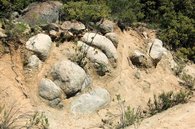Background
When rocks exposed at the Earth surface start to weather and break down chemically, CO2 from the atmosphere is being consumed. That is because carbonic acid, formed from CO2 and H2O in rain or soil water, is neutralized when reacting with silicate minerals such as anorthite that contain much Ca2+. The final product is calcium carbonate precipitated in the ocean, while on land, clay minerals remain from this break-down reaction. This weathering process is strongly coupled to erosional and soil forming processes. During erosion, rocks that have been uplifted by rock formation are physically crushed and transported away by gravity, wind, ice and water. The faster this happens, the shorter the retention time in the soil. Within the soil, biotic processes may additionally contribute to the weathering of minerals. In our section, we quantify the links between erosion, weathering, tectonics and climatic processes.
Two important rock types for these reactions are basalt, rich in Mg2+ and Ca2+, and carbonate, very rich in Ca2+. While basalt is a long-term sink for CO2, carbonate is, due to the precipitation in the ocean that releases again CO2, only a temporary sink.
Scientific key questions
- How variable are erosion and weathering rates at different time scales?
- What controls basalt and carbonate weathering, two major rock types at Earth surface, as function of climate?
- Is the strength of the weathering signal of basaltic volcanic rock coupled to the age of the volcanism?
Related projects
- Present and Past Weathering Fluxes from Tropical Volcanic Islands | PALAVAS
- Deciphering the Effect of Vegetation and Erosion on basalt and carbonate weathering by Novel Denudation Rate Approaches | DEVENDRA
- The coupled vegetation, weathering, erosion, and sediment-export response to climate change unravelled from novel proxies in Chilean marine sediment | SECCO
- Quantifying the Response of Rapidly Eroding Landscapes to Climate Change with Cosmogenic Nuclides | QUARREL
- Himalayan Paleo-Erosion Rates during the Plio-Pleistocene Climatic Transitions | HIPER




